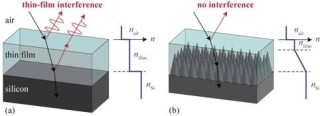
New technology inspired by the structure of moth eyes could improve efficiency in certain types of solar cells, according to US researchers.
Scientists from North Carolina State University have developed nanostructures that should limit reflection in thin-film cells made from several layers of photovoltaic material, meaning more light would be absorbed and more electricity produced.
The researchers built a nanostructure resembling a tightly-packed forest of thin cones into a film layer to reduce the amount of optical interference that occurs where it meets another layer – a problem that causes some of light that enters the cell to be reflected and so isn’t used to generate electricity.
‘We were inspired by the surface structure of a moth’s eye, which has evolved so that it doesn’t reflect light,’ said NC State’s Dr Chih-Hao Chang, who has co-authored a paper on the research for the journal Nanotechnology. ‘By mimicking that concept, we’ve developed a nanostructure that significantly minimizes thin-film interference.’
Thin-film interference occurs when light passes through two different substances, is reflected by the bottom layer and is then bent as it passes back through the top layer – it’s what produces the rainbow colours when petrol floats on water.
This interference is a problem for thin-film solar cells because light is lost at every interface between layers. To counter it, the NC State researchers built a nanostrutured interface they claim reflects 100 times less light would occur without the nanostructures.
‘Our next steps are to design a solar device that takes advantage of this concept and to determine how we can scale it up for commercial applications,’ said Chang.
The research was supported by a NASA Early Career Faculty Award and the National Science Foundation’s ASSIST Engineering Research Center at NC State.
Swiss scientists earlier this year claimed to have developed thin-film solar cells with a record efficiency of 20.4 per cent. (As opposed to the 5-18 percent efficiency at which most solar cells work)
Taken from: http://www.theengineer.co.uk/energy-and-environment/news/moth-eyes-provide-inspiration-for-solar-cell-improvement/1016346.article
































